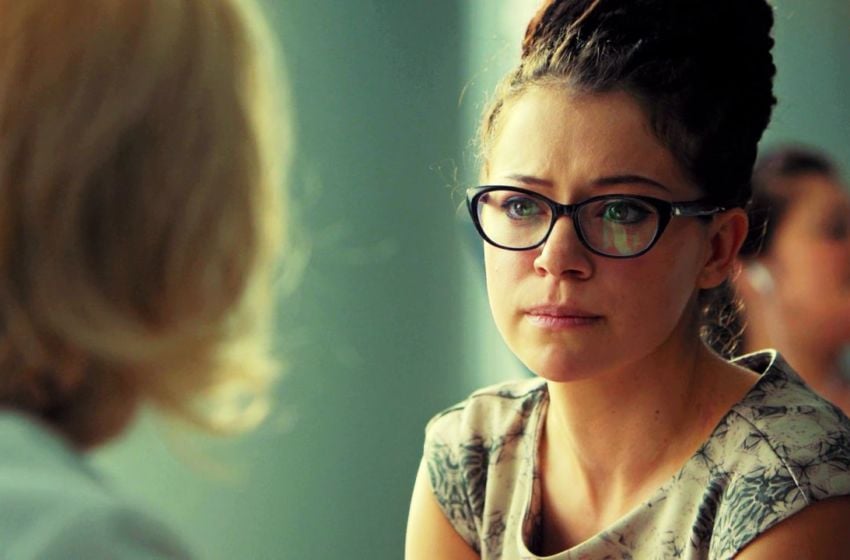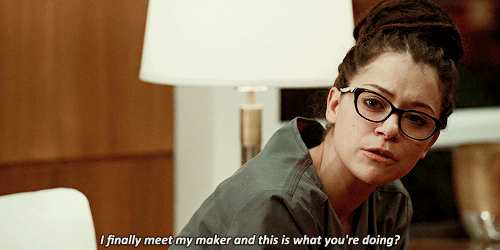Welcome to our Orphan Black science recaps, where Casey, a graduate student in genetics and developmental biology, and Nina, a professional science communicator, examine the science in each episode of OB and talk you through it in (mostly) easy-to-digest terms.
If you haven’t watched the latest episode of Orphan Black, be forewarned: there will be spoilers. There will also be crazy science.
Casey: This episode gave us a first look inside Bright Born and, in turn, began to uncover the truth behind much of the experimentation we’ve seen throughout Orphan Black. During Cosima’s first failed attempt at sneaking into the laboratories, she does manage to have a chat with Susan Duncan about the purpose of the Bright Born fertility program. Not only are the scientists manipulating the genomes of the babies to ensure that they are the healthiest, strongest, and best they can be, but they are also focused on making these manipulations heritable—that is, they can pass these preferred traits on generation to generation.
The process by which this is done is known as germ line editing. The germ line are the cells in the body that can give rise to offspring—that is, the sperm and the eggs. Most forms of genetic manipulation (gene therapy like in the case of the Neolution Worms or genome selection of fertilized embryos) alter the organism in question but do not allow these alterations to be passed on to the offspring. Germ line editing, however, involves manipulating the genome of the organism in both the somatic cells of the body and the germ line cells. This way, the organism—a person in the case of Orphan Black—will be genetically manipulated, and then these manipulations can be passed on to their offspring without the need for further experimentation.
Germ line editing is fundamentally necessary to succeed in creating a sustainable race of “better humans.” By simply manipulating the genomes in the germ cells of the Neolutionists with the Worm implants, and the babies in the fertility clinic, Susan and her team will have created a population of altered humans with the ability to propagate these genes for future generations to come—equal parts incredible and terrifying.
Nina: Cosima’s suspicions are confirmed once she dons some medical scrubs and does some sleuthing around Bright Born. Women are being held at Bright Born as part of a clinical trial to carry designer “Bright Born babies”—they’re technically there voluntarily and apparently well-compensated, but from the interactions we see between staff and trial participants, these women aren’t exactly happy about the restrictions imposed on them, and it’s unclear whether they have entirely informed consent about the genetically-altered babies that they’re carrying.
Cosima assists in the delivery of one of these babies, who turns out to have a rare but very real genetic condition known as popliteal pterygium syndrome (PPS or PP syndrome, as the Bright Born doctor calls it). This condition is caused by a mutation in a gene that codes for a protein that is important for controlling the development of tissues in the head, face, skin, and genitals.
Cosima is found out by Susan Duncan at this point, who chooses to reveal herself and to provide Cosima with some long-sought answers about Project Leda. Susan tells Cosima that she created the Leda clones “as a beautiful baseline to unlock the mysteries of the human genome”. Cosima compares the Leda clones to Oncomouse, a creature who, by genetic design, is meant as a research tool. Oncomouse sparked controversy in the 80s and 90s over what it means to patent living organisms (a familiar theme on Orphan Black) and the ethics of gene editing and germ line editing. It was the first animal ever to receive patent protection, but more importantly, it was a type of transgenic laboratory mouse: these mice had been genetically modified to carry a human oncogene (genetic material with the potential to cause cancer) and as such are highly susceptible to developing cancerous tumors. This susceptibility to cancer is also heritable, which makes them useful as models for cancer research.
As Susan Duncan’s “Oncomice”, the Leda clones are a genetic template for researching the human genome and identifying strategies for engineering healthier, superior humans. When the Duncans and Dyad/Neolution/whoever’s pulling the strings now lost the data for Project Leda they’ve had to resort to the methods that Casey described, like Bright Born’s gene-altered babies and the Neolution Worm.
Casey: It looks like “the greater good” is even more unsettling than it originally seemed. Susan has managed to create an entire human experimental system to study the genome and create the perfect humans, but as we can see the results can be horrifying, and the fate of many of the Leda clones remain uncertain.
Casey Griffin is a graduate student in genetics and developmental biology. She dissects mouse hearts, does lots of PCRs, and nerds (and cries and screams) about Orphan Black. You can check out her OB Science Time Tumblr posts here.
Nina Nesseth is a professional science communicator, writer, and serial tea-drinker. She’s happiest when science-ing at people (yes, that’s “science” as a verb). You can find her on Twitter @cestmabiologie.
—Please make note of The Mary Sue’s general comment policy.—
Do you follow The Mary Sue on Twitter, Facebook, Tumblr, Pinterest, & Google +?









